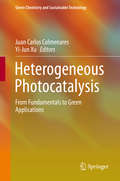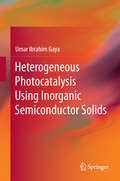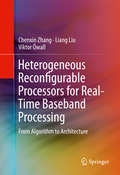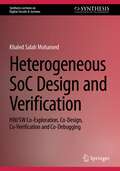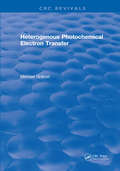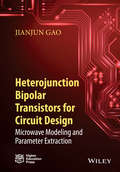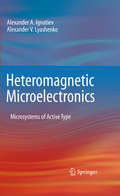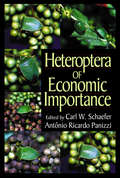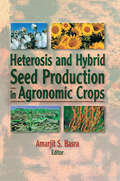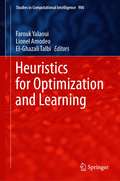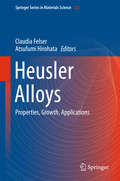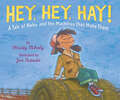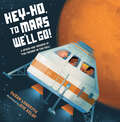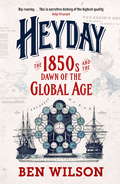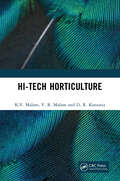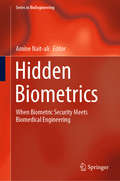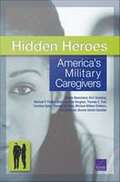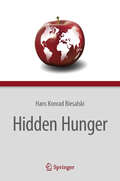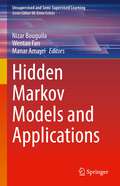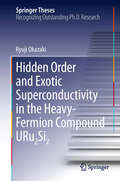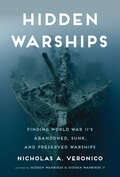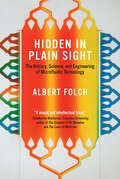- Table View
- List View
Heterogeneous Photocatalysis
by Juan Carlos Colmenares Yi-Jun XuThe book explains the principles and fundamentals of photocatalysis and highlights the current developments and future potential of the green-chemistry-oriented applications of various inorganic, organic, and hybrid photocatalysts. The book consists of eleven chapters, including the principles and fundamentals of heterogeneous photocatalysis; the mechanisms and dynamics of surface photocatalysis; research on TiO2-based composites with unique nanostructures; the latest developments and advances in exploiting photocatalyst alternatives to TiO2; and photocatalytic materials for applications other than the traditional degradation of pollutants, such as carbon dioxide reduction, water oxidation, a complete spectrum of selective organic transformations and water splitting by photocatalytic reduction. In addition, heterogeneized polyoxometalate materials for photocatalytic purposes and the proper design of photocatalytic reactors and modeling of light are also discussed. This book appeals to a wide readership of the academic and industrial researchers and it can also be used in the classroom for undergraduate and graduate students focusing on heterogeneous photocatalysis, sustainable chemistry, energy conversion and storage, nanotechnology, chemical engineering, environmental protection, optoelectronics, sensors, and surface and interface science. Juan Carlos Colmenares is a Professor at the Institute of Physical Chemistry, Polish Academy of Sciences, Poland. Yi-Jun Xu is a Professor at the State Key Laboratory of Photocatalysis on Energy and Environment, College of Chemistry, Fuzhou University, China.
Heterogeneous Photocatalysis Using Inorganic Semiconductor Solids
by Umar Ibrahim GayaThis book underscores the essential principles of photocatalysis and provides an update on its scientific foundations, research advances, and current opinions, and interpretations. It consists of an introduction to the concepts that form the backbone of photocatalysis, from the principles of solid-state chemistry and physics to the role of reactive oxidizing species. Having recognised the organic link with chemical kinetics, part of the book describes kinetic concepts as they apply to photocatalysis. The dependence of rate on the reaction conditions and parameters is detailed, the retrospective and prospective aspects of the mechanism of photocatalysis are highlighted, and the adsorption models, photocatalytic rate expressions, and kinetic disguises are examined. This book also discusses the structure, property, and activity relationship of prototypical semiconductor photocatalysts and reviews how to extend their spectral absorption to the visible region to enable the effective use of visible solar spectrum. Lastly, it presents strategies for deriving substantially improved photoactivity from semiconductor materials to support the latest applications and potential trends.
Heterogeneous Reconfigurable Processors for Real-Time Baseband Processing
by Liang Liu Viktor Öwall Chenxin ZhangThis book focuses on domain-specific heterogeneous reconfigurable architectures, demonstrating for readers a computing platform which is flexible enough to support multiple standards, multiple modes, and multiple algorithms. The content is multi-disciplinary, covering areas of wireless communication, computing architecture, and circuit design. The platform described provides real-time processing capability with reasonable implementation cost, achieving balanced trade-offs among flexibility, performance, and hardware costs. The authors discuss efficient design methods for wireless communication processing platforms, from both an algorithm and architecture design perspective. Coverage also includes computing platforms for different wireless technologies and standards, including MIMO, OFDM, Massive MIMO, DVB, WLAN, LTE/LTE-A, and 5G.
Heterogeneous SoC Design and Verification: HW/SW Co-Exploration, Co-Design, Co-Verification and Co-Debugging (Synthesis Lectures on Digital Circuits & Systems)
by Khaled Salah MohamedThis book covers the foundations of hardware/software codesign, on-chip communication, debugging, and verification, for heterogenous SoCs. Its primary objective is to empower designers in making informed decisions, guiding them to strike the perfect balance between flexibility and performance for their SoC designs. Readers will benefit from a detailed exploration of the essential elements of the hardware and software codesign framework, accompanied by a discussion of the driving motivations behind this approach. The author also provides an in-depth review of various hardware design architectures, shedding light on different design possibilities. Furthermore, the book presents key concepts concerning hardware and software communication, unraveling the intricate interactions within an SoC. This book provides a holistic introduction to the methodologies underpinning SoC design and verification, making it an indispensable companion for both novice and experienced designers navigating the ever-evolving landscape of hardware/software codesign.
Heterogenous Photochemical Electron Transfer
by Michael GratzelThe present monograph attempts to unify these diverse and exciting new developments within a common framework. First, the physical principles underlying heterogenous electron-transfer processes are outlined in a concise way and are compared to the homogeneous counterpart. This analysis includes the notion of the Fermi level in liquids and solids as well as the distribution of electronic energy levels in solids and liquids. A comparison is made between the salient kinetic features of homogeneous and heterogeneous electron transfer reactions. This establishes the basis for the subsequent treatment of the transduction of excitation energy and photo-initiated electron transfer in organized molecular assemblies, such as micelles, vesicles and monolayers. Transmembrane redox processes are critically reviewed. Particular attention is given to semiconductor electrodes and particles. This includes a discussion of quantum size effects, the nature of space charge layers as well as surface states and the dynamics of charge carrier-induced redox reactions at the semiconductor solution interface. These processes are of fundamental importance in such diverse fields as photochromism, electrochromic displays, electroreprography and photography, information storage, photocatalysis, photodegradation of paints, and solar energy conversion.
Heterojunction Bipolar Transistors for Circuit Design: Microwave Modeling and Parameter Extraction
by Jianjun GaoA highly comprehensive summary on circuit related modeling techniques and parameter extraction methods for heterojunction bipolar transistors Heterojunction Bipolar Transistor (HBT) is one of the most important devices for microwave applications. The book details the accurate device modeling for HBTs and high level IC design using HBTs Provides a valuable reference to basic modeling issues and specific semiconductor device models encountered in circuit simulators, with a thorough reference list at the end of each chapter for onward learning Offers an overview on modeling techniques and parameter extraction methods for heterojunction bipolar transistors focusing on circuit simulation and design Presents electrical/RF engineering-related theory and tools and include equivalent circuits and their matrix descriptions, noise, small and large signal analysis methods
Heteromagnetic Microelectronics
by Alexander A. Ignatiev Alexander V. LyashenkoThe book is devoted to a new direction - heteromagnetic microelectronics, microsystems of active type, research and development which will lead to the creation of new types of devices, CHIP'S, including intellectual. Polyvalent, multiple parameter magnetosemiconductor microsystems are described; extensive experimental and theoretical results of researches in a range of frequencies up to 1000GHz of such microsystems in active modes - generation, amplification, parametrical multiplication and division, direct multipurpose synthesis of signals on a crystal, generation equidistant grids of frequencies, reduction of noise are resulted, and applications of the above are discussed. The book is also based on original material from the author's programs of designing heteromagnetic microsystems of various types. For the first time the direction of satisfying criteria, burst technologies which can make a subject of discovery, are discussed in great volume. The book demonstrates a direction of development heteromagnetic technologies, including dimensional nanotechnologies, opportunities of new development in some new directions including heteromagnetic lasers, heteromagnetic diodes, uniform metrological element base, uniform sensors base and intellectual sensors, microsystems, etc.
Heterophase Network Polymers: Synthesis, Characterization, and Properties (Polymer Chemistry And Physics Ser.)
by Boris A. Rozenberg; Grigori M. SigalovThis volume explains the theory and experimental investigations in the preparation of heterophase polymer network materials through cure reaction-induced microphase separation (CRIMPS). It describes the synthesis of a new family of block- and graft-copolymers with controlled solubility in epoxies and characterizes CRIMPS processes using novel applications of known methods such as nuclear magnetic resonance, electron spin resonance and photochemistry. The text develops a new method for characterizing the molecular mass distribution (MMD) of linear and network polymers using thermomechanical analysis data, as well as new methods for determining internal stresses and flaw formation during thermoset curing. The CRIMPS theory will be helpful for researchers and engineers designing and improving toughened plastics and other smart heterophase network materials for different applications. The new method for MMD characterization of polymers in bulk will be very useful to quickly analyze a polymer's MMD and to design new polymers. This book will provide a useful reference for graduates, researchers and working professionals in polymer chemistry and physics and materials science.
Heteroptera of Economic Importance
by Carl W. Schaefer Antonio Ricardo PanizziHeteropterans regularly cause a wide variety and large number of problems for humans - at times on a catastrophic scale. The 37,000 described species of this suborder including many pests, disease transmitters, and nuisances exist worldwide, inflicting damage on crops, forests, orchards, and human life. Inspired by the widespread economic impact of
Heterosis and Hybrid Seed Production in Agronomic Crops
by Amarjit S. BasraHeterosis and Hybrid Seed Production in Agronomic Crops discusses how heterosis or “hybrid vigor” has played a major role in improving crop productivity and quality in order to feed the ever-increasing human population, particularly in developing countries. Plant breeders, agronomists, seed producers, and farmers will discover why the development of hybrids in the world's major food crops and why the methods of hybrid seed production are critical for achieving this goal. This landmark book deals with heterosis and hybrid seed production of major agronomic crops such as wheat, rice, maize, sorghum, cotton, sunflower, and rapeseed. Through Heterosis and Hybrid Seed Production in Agronomic Crops, you will discover valuable information on hybrid seed production methods that is not available in any other single volume. This unique book contains relevant and essential information about important procedures to help increase crop yield, including: methods for deriving second cycle inbred lines for hybrid maize possibilities for hybrid seed production in wheat techniques of hybrid sorghum seed production production of hybrid seeds using male sterile lines of cotton agronomic management in seed production plots of sunflower seed production technology of hybrid rapeseed advances in hybrid seed production technology of rice in China Heterosis and Hybrid Seed Production in Agronomic Crops gives you a global perspective on essential food crops in all parts of the world. This informative guide will help you use hybrid seed production methods with important agricultural crops and increase the quality of these vital and essential food sources.
Heuristics for Optimization and Learning (Studies in Computational Intelligence #906)
by Lionel Amodeo Farouk Yalaoui El-Ghazali TalbiThis book is a new contribution aiming to give some last research findings in the field of optimization and computing. This work is in the same field target than our two previous books published: “Recent Developments in Metaheuristics” and “Metaheuristics for Production Systems”, books in Springer Series in Operations Research/Computer Science Interfaces. The challenge with this work is to gather the main contribution in three fields, optimization technique for production decision, general development for optimization and computing method and wider spread applications. The number of researches dealing with decision maker tool and optimization method grows very quickly these last years and in a large number of fields. We may be able to read nice and worthy works from research developed in chemical, mechanical, computing, automotive and many other fields.
Heusler Alloys
by Claudia Felser Atsufumi HirohataThis book gives an overview of the physics of Heusler compounds ranging from fundamental properties of these alloys to their applications. Especially Heusler compounds as half-metallic ferromagnetic and topological insulators are important in condensed matter science due to their potential in magnetism and as materials for energy conversion. The book is written by world-leaders in this field. It offers an ideal reference to researchers at any level.
Hey, Hey, Hay!
by Christy MihalyEvery bale of hay has a little bit of summer sun stored in the heart of it— learn from a mother-daughter team how hay is made! Feeding her horses one cold and wintry day, a girl thinks about all the hard work that went into the fresh-smelling bales she's using. The rhyming text and brilliant full-page paintings follow the girl and her mother through the summer as they cut, spread, dry and bale in the fields. Mower blades slice through the grass./A new row falls with every pass./Next we spread the grass to dry./The tedder makes those grasses fly! This celebration of summer, farming, and family, illustrated by Pura Belpré honor artist Joe Cepeda, includes a glossary of haymaking words, and a recipe for making your own switchel— a traditional farm drink, to cool you down in the summer heat. A Bank Street Best Children's Book of the Year
Hey-Ho, to Mars We'll Go!: A Space-Age Version of "The Farmer in the Dell"
by Susan LendrothPerfect for STEM and space storytimes, this musical mission to Mars will have young astronauts singing along as they learn the science of space travel.Explore the science behind a trip to Mars, from launch to landing on the Red Planet. Set to the tune of "The Farmer in the Dell," this jaunty journey follows five adorable, bobble-headed astronauts as they learn how to bathe in zero gravity, grow veggies in space, and entertain themselves on the six-month trip. Even the design of the book defies gravity, as text and art float free on the page, encouraging readers to turn the book sideways and upside-down.
Heyday: Britain and the Birth of the Modern World
by Ben Wilson'Excellent . . . This is narrative history of the highest quality' Andrew Lycett, Sunday Telegraph'Wonderfully engrossing and intelligent . . . clever and entertaining' Dominic Sandbrook, Sunday TimesHEYDAY brings to life one of the most extraordinary periods in modern history. The 1850s was a decade of breathtaking transformation, with striking parallels for our own times. The world was reshaped by technology, trade, mass migration and war. The global economy expanded fivefold, millions of families emigrated to the ends of the earth to carve out new lives, technology revolutionised communications, while steamships and railways cut across vast continents and oceans, shrinking the world and creating the first global age.In a fast-paced, kaleidoscopic narrative, the acclaimed historian Ben Wilson recreates this time of explosive energy and dizzying change, a rollercoaster ride of booms and bust, focusing on the lives of the men and women reshaping its frontiers. At the centre stands Great Britain. The country was the peak of its power as it attempted to determine the destinies of hundreds of millions of people. A dazzling history of a tumultuous decade, HEYDAY reclaims an often overlooked period that was fundamental not only in in the making of Britain but of the modern world.
Hi-Tech Horticulture
by K.V. Malam V. R. Malam D. R. KanzariaThis book demonstrates applications of the basic principles of horticulture and illustrates how they can be used systematically to define—and eventually control—existing phenomena. It comprises of various practices for evaluating the technologies used in horticulture. It will meet the growing need of students, teachers, and researchers alike in the field of horticulture and those working in agricultural universities and other related private firms. Print edition not for sale in India.
Hidden Biometrics: When Biometric Security Meets Biomedical Engineering (Series in BioEngineering)
by Amine Nait-AliThis book explores intrinsic and human body part biometrics and biometrics of human physiological activities, invisible to the naked eye. This includes, for instance, brain structures, skeleton morphology, heart activity, etc. These human body parts can only be visualized using specific imaging techniques or sensors, commonly employed in the biomedical engineering field. As such, the book connects two fields, namely biometric security and biomedical engineering.The book is suitable for advanced graduate and postgraduate students, engineers and researchers, especially in Signal and Image Processing, Biometrics, and Biomedical Engineering.
Hidden Heroes: America's Military Caregivers
by Terri Tanielian Rajeev Ramchand Michael P. Fisher Christine Anne Vaughan Thomas E. Trail Caroline Epley Phoenix Voorhies Michael William Robbins Eric Robinson Bonnie Ghosh-DastidarLittle has been reported about "military caregivers"--the population of those who care for wounded, ill, and injured military personnel and veterans. This report summarizes the results of a study designed to describe the magnitude of military caregiving in the United States today, as well as to identify gaps in the array of programs, policies, and initiatives designed to support military caregivers.
Hidden Hunger
by Hans Konrad Biesalski Patrick O'MealyHidden Hunger is an increasing problem even in developed countries, whose potential negative consequences on long-term health are often overlooked and underestimated. Chronic malnutrition is at the core of the global hunger challenge facing science, politics, and economics. In plain language and with moving examples, Hans K. Biesalski describes how hidden hunger affects human health long before malnutrition becomes obvious. Worldwide, over one third of deaths among children under 5 years of age is associated with malnutrition. As poverty is the main reason for hidden hunger, addressing this dire challenge requires long-term policies. Land grabbing and climate change seriously counteract a lot of efforts to overcome hidden hunger. This book is a highly impressive call to action. Investment in agriculture and in particular in small-scale farmers to improve subsistence farming are among the approaches suggested to reach a sustainable solution. The author is head of the department of biochemistry and nutrition and managing director of the Food Security Center at the University of Hohenheim, Germany. He is a member of numerous advisory and expert groups for the World Health Organization (WHO), the Food and Agriculture Organization (FAO) and the Global Forum on Food Security and Nutrition.
Hidden Markov Models and Applications (Unsupervised and Semi-Supervised Learning)
by Nizar Bouguila Wentao Fan Manar AmayriThis book focuses on recent advances, approaches, theories, and applications related Hidden Markov Models (HMMs). In particular, the book presents recent inference frameworks and applications that consider HMMs. The authors discuss challenging problems that exist when considering HMMs for a specific task or application, such as estimation or selection, etc. The goal of this volume is to summarize the recent advances and modern approaches related to these problems. The book also reports advances on classic but difficult problems in HMMs such as inference and feature selection and describes real-world applications of HMMs from several domains. The book pertains to researchers and graduate students, who will gain a clear view of recent developments related to HMMs and their applications.
Hidden Order and Exotic Superconductivity in the Heavy-Fermion Compound URu2Si2
by Ryuji OkazakiIn this thesis, the author investigates hidden-order phase transition at T0 = 17. 5 K in the heavy-fermion URu2Si2. The four-fold rotational symmetry breaking in the hidden order phase, which imposes a strong constraint on the theoretical model, is observed through the magnetic torque measurement. The translationally invariant phase with broken rotational symmetry is interpreted as meaning that the hidden-order phase is an electronic "nematic" phase. The observation of such nematicity in URu2Si2 indicates a ubiquitous nature among the strongly correlated electron systems. The author also studies the superconducting state of URu2Si2 below Tc = 1. 4 K, which coexists with the hidden-order phase. A peculiar vortex penetration in the superconducting state is found, which may be related to the rotational symmetry breaking in the hidden-order phase. The author also identifies a vortex lattice melting transition. This transport study provides essential clues to the underlying issue of quasiparticle dynamics as to whether a quasiparticle Bloch state is realized in the periodic vortex lattice.
Hidden Powers: Lise Meitner's Call to Science
by Jeannine AtkinsFrom the acclaimed author of Finding Wonders and Grasping Mysteries comes a gorgeously written biography in verse about the pioneering Jewish woman physicist whose scientific prowess changed the course of World War II. At the turn of the 20th century, Lise Meitner dreamed of becoming a scientist. In her time, girls were not supposed to want careers, much less ones in science. But Lise was smart—and determined. She earned a PhD in physics, then became the first woman physics professor at the University of Berlin. The work was thrilling, but Nazi Germany was a dangerous place for a Jewish woman. When the risks grew too great, Lise escaped to Sweden, where she continued the experiments that she and her laboratory partner had worked on for years. Her efforts led to the discovery of nuclear fission and altered the course of history. Only Lise&’s partner, a man, received the Nobel Prize for their findings, but this moving and accessible biography shows how Lise&’s legacy endures.
Hidden Warships: Find World War II's Abandoned, Sunk, and Preserved Warships
by Nicholas A. VeronicoA photo-filled tour of wrecked warships around the world, with their stories recounted in “a wonderfully clear [and] lively style” (Seattle Post Intelligencer).Sunk by enemy fire, scuttled, or run aground, the number of World War II-era battleships, cruisers, submarines, and other warships that ended their service on the bottom of the world’s oceans and seas is enormous. In the decades since the conflict, wreck hunters have pored over historical records and combed the world’s oceans to find their remains. Now you too can see them up close—without getting your feet wet.In Hidden Warships, naval historian Nicholas A. Veronico details the history, recovery, and preservation of these sunken combat ships—including accounts from the divers and restorers who have worked with them. Beginning with the Japanese midget submarines that attacked Pearl Harbor and continuing into the modern era, including the 2006 sinking of the postwar aircraft carrier USS Oriskany, Veronico provides rich detail on each noteworthy vessel, including over 150 photographs, ship specifications, geographic coordinates, and more. For the enthusiast who wants an even more complete experience, the book concludes with a list of preserved ships, an Internet resource guide, and a suggested reading list to continue the exploration.Whether you plan on visiting these historic sites yourself or simply enjoy their compelling stories, Hidden Warships will guide you, above the surface and underwater, through some of the most famous relics of World War II naval warfare.“A tantalizing selection of sunken vessels, including many recent discoveries.” —Naval History Magazine
Hidden in Plain Sight: The History, Science, and Engineering of Microfluidic Technology
by Albert FolchStories behind essential microfluidic devices, from the inkjet printer to DNA sequencing chip.Hidden from view, microfluidics underlies a variety of devices that are essential to our lives, from inkjet printers to glucometers for the monitoring of diabetes. Microfluidics—which refers to the technology of miniature fluidic devices and the study of fluids at submillimeter levels—is invisible to most of us because it is hidden beneath ingenious user interfaces. In this book, Albert Folch, a leading researcher in microfluidics, describes the development and use of key microfluidic devices. He explains not only the technology but also the efforts, teams, places, and circumstances that enabled these inventions. Folch reports, for example, that the inkjet printer was one of the first microfluidic devices invented, and traces its roots back to nineteenth-century discoveries in the behavior of fluid jets. He also describes how rapid speed microfluidic DNA sequencers have enabled the sequencing of animal, plant, and microbial species genomes; organs on chips facilitate direct tests of drugs on human tissue, leapfrogging over the usual stage of animal testing; at-home pregnancy tests are based on clever microfluidic principles; microfluidics can be used to detect cancer cells in the early stages of metastasis; and the same technology that shoots droplets of ink on paper in inkjet printers enables 3D printers to dispense layers of polymers. Folch tells the stories behind these devices in an engaging style, accessible to nonspecialists. More than 100 color illustrations show readers amazing images of microfluids under the microscope.
Hidden: First In A New Mystery Series (The Black Hat Thrillers #1)
by Karen E. OlsonA computer hacker&’s criminal past comes back to haunt her in this &“edge-of-your-seat thriller&” from the author of Vanished (Alison Gaylin, USA Today–bestselling author). Nicole Jones lives off the grid. She doesn&’t have a driver&’s license, passport, or even a bank account. She definitely doesn&’t own a computer. Operating bike tours on Block Island, she hasn&’t left her New England refuge in fifteen years. But it&’s not that she&’s afraid of the world. She&’s afraid of what she could do to it if she ever plugged back in. Because Nicole Jones isn&’t her real name. Still wanted by the FBI, she was once one of the best cyberthieves in the business. When the last person Nicole wants to see suddenly appears on the island, using a name he knows will draw her out, Nicole realizes that no one can hide forever—not even her. As her secret past comes to light and her carefully-constructed life starts to unravel, Nicole&’s long-time haven becomes a prison, and her only chance for survival is hacking her way out.
